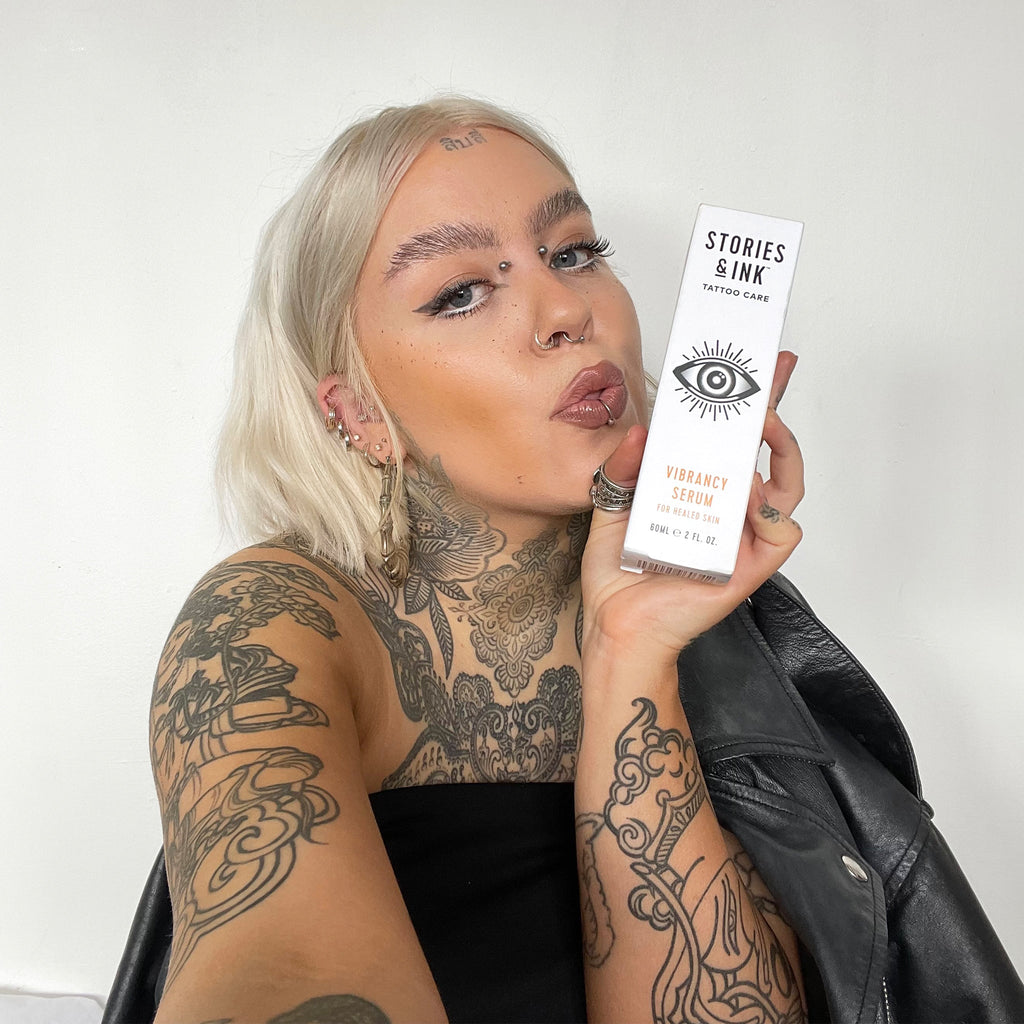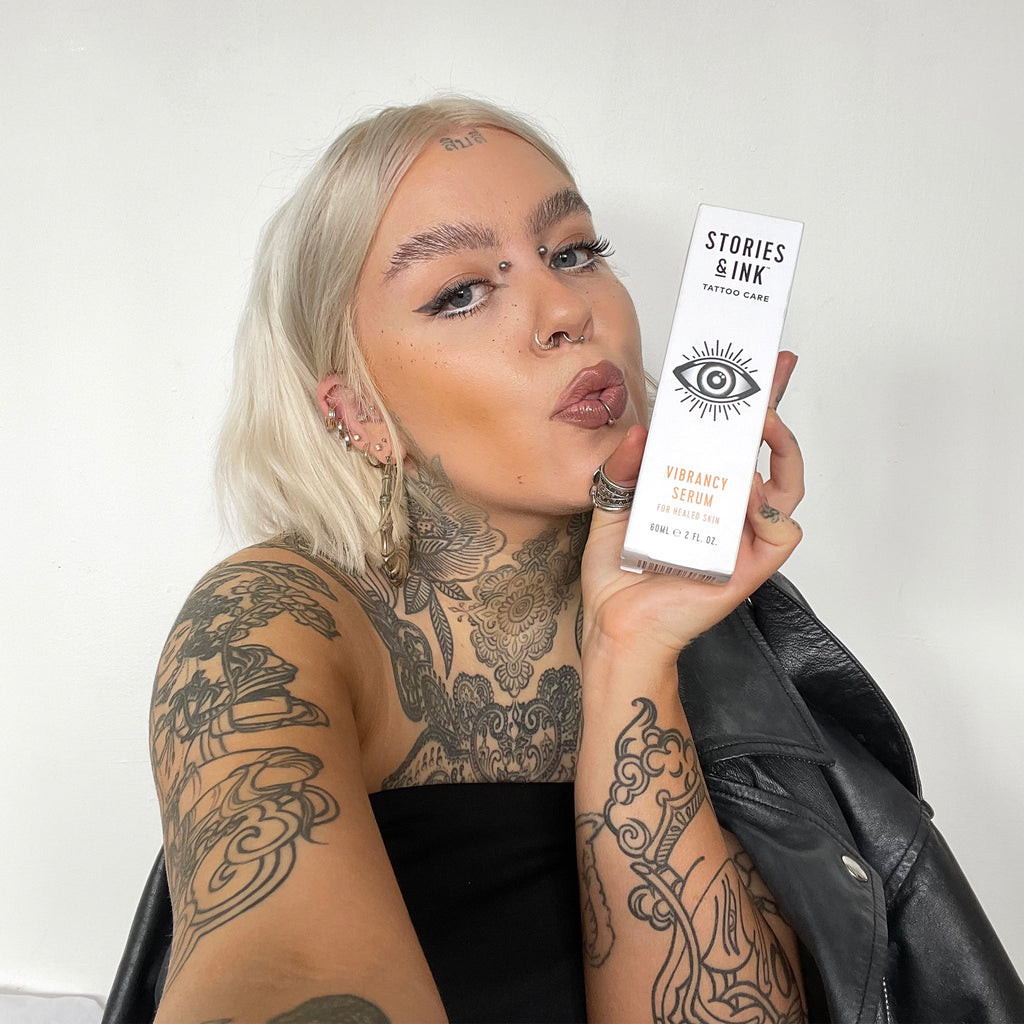Self tanner and tattoos can coexist, but understanding the interaction is key to protecting your body art. At tattooat.com, we provide expert guidance on tattoo aftercare, ensuring your ink remains vibrant and your skin stays healthy. Learn how to safely maintain your faux glow while preserving the beauty of your tattoos, keeping both your skin and artwork in top condition.
1. Can You Tattoo Over Fake Tan?
No, you cannot tattoo over fake tan. According to Sarah of @big.bird.tattoo, fake tan interferes with the tattooing process, as the skin needs to be clean for the appointment. It’s essential to avoid applying self tanner to the area before getting a tattoo to ensure the artist can work effectively.
Fake tan creates a barrier on the skin that can affect stencil application and visibility during the tattooing process. The pigments in self tanner can also mix with the tattoo ink, potentially altering the final appearance of the tattoo. Proper skin preparation is crucial for achieving the best possible tattoo outcome. According to research from Portland State University’s Art Department, in July 2023, clean, clear skin is essential for optimal tattoo application. For the best results, always consult with your tattoo artist for specific pre-tattoo skincare recommendations.
2. What Types of Tan Should Be Avoided Before Getting a Tattoo?
Several types of tanning should be avoided before getting a tattoo, including spray tans, gradual tans, sunbathing, and sunbeds. Each of these methods can negatively impact the tattooing process and the healing of your new tattoo.
2.1 Spray Tan
Spray tans, often applied by a beauty therapist, contain dihydroxyacetone (DHA), which darkens the skin’s surface. Sarah from @big.bird.tattoo notes that pigments in spray tan can interfere with the tattoo design and should be avoided in the weeks leading up to your appointment. Moreover, exfoliating before a tattoo is recommended, which is contrary to spray tan aftercare.
2.2 Gradual Tan
Gradual tan, typically mixed with moisturizer, is designed to darken the skin tone gradually over several days. While it’s a milder form of self tanner, it still leaves a coating on the skin that can interfere with the tattooing process. It is best to avoid gradual tan until your new tattoo has fully healed.
2.3 Sunbathing
Sunbathing before a tattoo session is not recommended. Tattoo artists may refuse to work on sunburned skin due to the risk of impaired healing and increased soreness. Sun damage compromises the skin’s integrity, making it unsuitable for tattooing.
2.4 Sunbeds
Sunbeds emit harmful UV rays similar to the sun, increasing the risk of sunburn. Like sunbathing, sunbeds should be avoided before your tattoo appointment. Additionally, sunbeds can fade existing tattoos, especially those with colored ink. It is advised to wait at least eight weeks after your tattoo has fully healed before using tanning beds.
3. How to Prep Your Skin Before a Tattoo Appointment?
Proper skin preparation is crucial for a successful tattoo. Sarah from @big.bird.tattoo recommends removing any existing fake tan from the area to be tattooed. Steering clear of sunless tanning products and direct sun exposure is ideal.
3.1 Removing Fake Tan
If you’ve used self tanner before your appointment, remove as much as possible from the tattoo area. The skin will be cleaned before the stencil application, but removing the fake tan beforehand aids in this process.
3.2 Exfoliation and Moisturizing
Exfoliating and moisturizing your skin prepares it for the tattoo process. Use a gentle exfoliator to remove dead skin cells and a high-quality moisturizer to keep the skin hydrated. Stories & Ink offers an Exfoliating Body Wash and Daily Moisturiser, designed to keep your skin smooth and healthy.
4. Can I Use Self Tanner After Getting a Tattoo?
It’s best to avoid using self tanner for a few weeks after getting a new tattoo to allow it to heal properly. According to Sarah from @big.bird.tattoo, applying self tanner too soon can cause complications.
4.1 Healing Period
Allow 2-3 weeks for the tattoo to heal before applying any self tanner. The chemicals in self tanners can cause skin reactions and potentially lead to infections in the healing tattoo.
4.2 Potential Complications
Applying self tanner too soon can result in the need for touch-ups or, in more severe cases, infections. Waiting until the tattoo is fully healed ensures the best possible outcome for your skin and your tattoo.
5. How to Apply Self Tanner Around a New Tattoo Safely?
Once your tattoo has fully healed, you can safely apply self tanner. To protect your tattoo, ensure it is well-moisturized before applying the self tanner. This creates a barrier that minimizes the self tanner’s direct contact with the tattoo.
5.1 Moisturizing the Tattoo
Before applying self tanner, generously moisturize the tattoo. This helps to prevent the self tanner from overly affecting the tattoo’s color.
5.2 Application Technique
Apply the self tanner according to the product instructions, carefully avoiding direct application on the tattoo. Use a barrier cream or moisturizer to protect the tattoo while tanning the surrounding skin.
5.3 Considerations for Colored Ink
Colored ink might be affected by self tanner pigments, so self tanning is generally more successful with blackwork tattoos. Keep in mind that well-hydrated skin takes on self tanner better.
6. What are the Long-Term Effects of Self Tanner on Tattoos?
Long-term use of self tanner can potentially affect the vibrancy and appearance of tattoos, particularly those with colored ink. While self tanner primarily darkens the skin’s surface, the chemicals involved can interact with the tattoo ink over time.
6.1 Fading
Frequent application of self tanner may contribute to the fading of tattoo ink. The chemicals in self tanners can break down the pigment particles, causing the tattoo to appear less vibrant.
6.2 Color Alteration
Self tanner can alter the color of tattoos, especially those with lighter or more vibrant inks. The tanning pigments can blend with the tattoo ink, resulting in a change in the tattoo’s overall hue.
6.3 Skin Health
Maintaining healthy skin is essential for preserving the appearance of your tattoos. Self tanner can sometimes dry out the skin, which can affect the tattoo’s appearance. Regular moisturizing and proper skincare can help mitigate these effects.
7. How Can You Protect Your Tattoos While Using Self Tanner?
Protecting your tattoos while using self tanner involves several strategies, including moisturizing, using barrier creams, and choosing the right self tanner products. These steps can help minimize the potential impact on your tattoos.
7.1 Moisturizing
Regularly moisturizing your tattoos helps to create a barrier between the skin and the self tanner. This prevents the self tanner from directly affecting the tattoo ink.
7.2 Barrier Creams
Applying a barrier cream, such as petroleum jelly, over the tattoo before applying self tanner can provide an extra layer of protection. This prevents the self tanner from penetrating the tattoo area.
7.3 Choosing the Right Products
Opt for self tanners that are specifically formulated for sensitive skin or those with natural ingredients. These products are less likely to cause irritation or damage to your tattoos.
8. What Ingredients in Self Tanner Should You Avoid?
Certain ingredients in self tanners can be harmful to tattoos and the surrounding skin. Avoiding these ingredients can help protect your tattoos and maintain their vibrancy.
8.1 Alcohol
Alcohol can dry out the skin, which can affect the appearance of the tattoo. It’s best to choose self tanners that are alcohol-free to keep your skin hydrated.
8.2 Parabens
Parabens are preservatives that can cause skin irritation and allergic reactions. Opt for self tanners that are paraben-free to minimize the risk of skin issues.
8.3 Artificial Fragrances
Artificial fragrances can also cause skin irritation. Choose self tanners with natural fragrances or those that are fragrance-free to avoid potential problems.
9. How Does Sun Exposure Affect Tattoos Compared to Self Tanner?
Sun exposure and self tanner both affect tattoos, but in different ways. Understanding these differences can help you make informed decisions about how to protect your tattoos.
9.1 Sun Exposure
Sun exposure can cause tattoo ink to fade and break down over time. The sun’s UV rays penetrate the skin and damage the pigment particles, leading to a less vibrant tattoo.
9.2 Self Tanner
Self tanner darkens the skin’s surface, which can affect the appearance of the tattoo. While self tanner does not directly damage the tattoo ink, it can alter the tattoo’s color and vibrancy.
9.3 Comparison
While both sun exposure and self tanner can affect tattoos, sun exposure is generally more harmful. Protecting your tattoos from the sun is crucial for maintaining their appearance over the long term.
10. What Are Some Recommended Products for Tattoo Aftercare and Maintenance?
Proper aftercare and maintenance are essential for keeping your tattoos looking their best. Several products are designed to protect and enhance the appearance of tattoos.
10.1 Tattoo Balms
Tattoo balms, such as Stories & Ink Vibrancy Serum, contain ingredients that nourish and hydrate the skin, helping to keep the tattoo vibrant. These balms often include amino acids, which brighten and exfoliate dull-looking tattoos.
10.2 Moisturizers
Regular moisturizing is crucial for maintaining the appearance of your tattoos. Look for moisturizers that are specifically formulated for tattoos or those with natural ingredients.
10.3 Sunscreen
Protecting your tattoos from the sun is essential for preventing fading. Use a high-SPF sunscreen to shield your tattoos from harmful UV rays.
11. How to Choose a Tattoo Artist Who Understands Skin and Tanning?
Choosing a tattoo artist who understands skin and tanning is essential for ensuring the best possible outcome for your tattoos. A knowledgeable artist can provide guidance on how to prepare your skin before the tattoo and how to care for it afterward.
11.1 Research
Research potential tattoo artists and look for those with experience working with a variety of skin types and tones. Check their portfolios for examples of their work and read reviews from previous clients.
11.2 Consultation
Schedule a consultation with the tattoo artist to discuss your concerns about tanning and how it might affect your tattoo. A good artist will be able to provide advice on how to protect your tattoo and maintain its appearance.
11.3 Questions to Ask
Ask the tattoo artist about their experience with tattooing on tanned skin and what precautions they take to ensure the best results. Inquire about their recommendations for aftercare and how to protect your tattoo from sun exposure and self tanner.
12. What Are the Best Practices for Tattoo Healing?
Proper tattoo healing is crucial for ensuring that your tattoo looks its best and lasts for years to come. Following these best practices can help you avoid complications and promote healthy healing.
12.1 Cleaning
Keep your new tattoo clean by washing it gently with mild, fragrance-free soap and warm water. Avoid using harsh soaps or scrubbing the tattoo, as this can damage the skin.
12.2 Moisturizing
Apply a thin layer of tattoo balm or moisturizer to the tattoo several times a day. This helps to keep the skin hydrated and promotes healing.
12.3 Avoiding Sun Exposure
Protect your new tattoo from sun exposure by covering it with clothing or applying a high-SPF sunscreen. Sun exposure can cause the tattoo ink to fade and damage the healing skin.
13. What Are Some Common Myths About Tattoos and Tanning?
Several myths surround tattoos and tanning. Understanding the truth behind these myths can help you make informed decisions about how to care for your tattoos.
13.1 Myth: Self Tanner Protects Tattoos from the Sun
Self tanner does not protect tattoos from the sun. While it darkens the skin, it does not provide any protection from harmful UV rays. You still need to use sunscreen to protect your tattoos from sun exposure.
13.2 Myth: Tanning Beds Don’t Affect Tattoos
Tanning beds emit harmful UV rays that can damage tattoo ink and cause it to fade. It’s best to avoid tanning beds altogether to protect your tattoos.
13.3 Myth: You Can’t Use Self Tanner with Tattoos
You can use self tanner with tattoos, but you need to take precautions to protect the tattoo. Moisturizing and using barrier creams can help minimize the impact of self tanner on your tattoo.
14. How Can Tattooat.com Help You With Your Tattoo Journey?
Tattooat.com offers a wealth of information and resources to help you navigate your tattoo journey. From finding inspiration for your next tattoo to providing guidance on aftercare, Tattooat.com is your go-to source for all things tattoos.
14.1 Design Inspiration
Explore a vast library of tattoo designs to find inspiration for your next piece of body art. Whether you’re looking for traditional designs or something more modern, Tattooat.com has something for everyone.
14.2 Artist and Studio Directory
Find talented tattoo artists and reputable studios across the United States. Our directory includes detailed profiles of artists and studios, making it easy to find the perfect match for your style and preferences.
14.3 Expert Advice
Access detailed articles and guides on all aspects of tattoos, from preparation to aftercare. Our expert advice helps you make informed decisions and ensures that your tattoos look their best.
15. Frequently Asked Questions About Self Tanner and Tattoos
Here are some frequently asked questions about self tanner and tattoos to help you better understand how to care for your body art.
15.1 Can I get a tattoo if I have a tan?
It’s best to avoid getting a tattoo if you have a fresh tan, especially a sunburn. Tanned skin can affect the tattoo artist’s ability to work and may compromise the healing process.
15.2 How long after getting a tattoo can I use self tanner?
Wait at least 2-3 weeks after getting a tattoo before using self tanner to ensure that the tattoo is fully healed.
15.3 Will self tanner fade my tattoo?
Self tanner can potentially fade your tattoo over time, especially if you use it frequently. Protecting your tattoo with moisturizer and barrier creams can help minimize this effect.
15.4 What is the best way to protect my tattoo from the sun?
The best way to protect your tattoo from the sun is to cover it with clothing or apply a high-SPF sunscreen.
15.5 Can I use tanning beds after getting a tattoo?
It’s best to avoid tanning beds altogether to protect your tattoos from harmful UV rays.
15.6 How do I choose the right self tanner for my tattoos?
Choose self tanners that are specifically formulated for sensitive skin or those with natural ingredients to minimize the risk of irritation.
15.7 What ingredients should I avoid in self tanners?
Avoid self tanners that contain alcohol, parabens, and artificial fragrances, as these can irritate the skin and damage your tattoos.
15.8 Can I use gradual tanner on my tattoos?
Gradual tanner can be used on tattoos, but it’s important to take precautions to protect the tattoo by moisturizing and using barrier creams.
15.9 How often should I moisturize my tattoos?
Moisturize your tattoos several times a day to keep the skin hydrated and promote healthy healing.
15.10 What should I do if my tattoo gets sunburned?
If your tattoo gets sunburned, apply a cooling lotion or aloe vera to soothe the skin. Avoid further sun exposure until the sunburn has healed.
Ready to dive deeper into the world of tattoos? Visit tattooat.com today for endless design inspiration, a curated list of talented artists, and all the essential knowledge you need to make your tattoo dreams a reality!
Address: 1825 SW Broadway, Portland, OR 97201, United States
Phone: +1 (503) 725-3000
Website: tattooat.com
 Spray Tan
Spray Tan
 Daily Moisturiser
Daily Moisturiser


